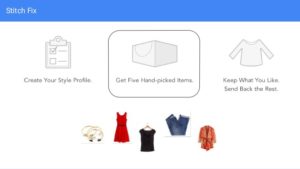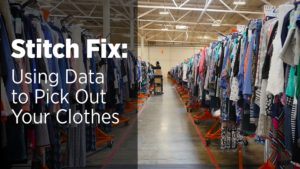Stitchfix: The Data-Driven Stylist

When curation meets data, does the curator become obsolete?
Stitchfix is ostensibly just another subscription eCommerce company. You select your style, get a box of styled clothing, and pick what you like, send the rest back. It’s a simple concept that’s somehow picked up an insane amount of traction: since its founding, Stitch Fix has grown to 4,000 employees, and has 5 logistics centers in the continental US. It has 3,000 stylists on payroll and has raised a total of $47M1.
But what has really been driving its growth? As you may guess from the title of the assignment, well, it’s data! Stitchfix’s proprietary algorithms and massive amounts of customer data drive perfect (or close-to-perfect) matching between boxes and customers. This drives retention and deeper spend / engagement.
So how do they do it? The first time users sign up for Stitchfix they answer a series of questions that cover topics like personal style, body type, or desired cost range (“the cheaper the better” is an option here)2. A profile is formed on the user that then feeds the stylist’s choices for their box and future styles.

If a customer sends the box back (i.e., chooses not to keep any of the items), she is charged a $20 shipping & handling fee (value capture). If she keeps any of the items, the $20 is applied to her purchase. Every returned or kept item is put into the system in order to further perfect that individual’s algorithm. It’s a wonderful system that works best when the box is carefully crafted to match the individual’s taste preferences.

Stitchfix knows its strategic advantage lies in data and has allocated resources accordingly. It’s built out a huge data sciences team (unheard of in the world of eCommerce), led by Eric Colson, the man behind Netflix’s recommendation engine3. The team has created a data sorting process that leverages 50 different algorithms that run all aspects of Stitchfix’s business. The algorithms help assign stylists to customers, inform warehouse operations, determine buying need down to the SKU-level, and yes, help stylists pick the right dress for the right customer. The data goes so far as to predict upcoming fashion trends2 so as to help stylists preempt demand.
I believe that Stitchfix is onto something big – so big in fact that it’ll be industry-shaping. It’s clever use of data science for everything from operations to execution makes it an inherently more efficient and technical retailer than the competition.
Retail / eCommerce is (generally) dismally bad at data, despite having loads of it. I believe that the next generation of excellent eCommerce companies will use data to drive business, rather than absorb data ex post facto. And in my opinion, companies like Stitchfix will be far ahead of the rest when it comes into fashion.

The one question I do have, though, is how the stylists feel about the data…and whether it’ll eventually put them out of a job.
- https://earlymoves.com/2017/01/30/stitch-fix-the-fashion-industrys-new-darling-is-ready-to-attack/
- http://www.mercurynews.com/2016/12/15/computing-out-fit-stitch-fix-algorithms-machine-learning-dress-customers/
- https://www.theinformation.com/stitch-fix-wants-to-go-for-retails-jugular




I had no idea how data was behind Stitchfix. Do you have any sense of how the brands feel about the business model? I imagine the information Stitchfix gathers could be very useful to the brands if they shared it (maybe for a price). I might worry that some brands now do not own the customer experience and therefore might want to avoid this as a channel for sales. If that’s true, then a limited brand selection could hurt Stichfix going forward.
Great point! I’m not sure if the brands have access to the data since as far as I know, the brands are commoditized on the platform – ie, customers differentiate on style, fit, colors vs. brands. The brands Stitchfix uses are typically up-and-coming or relatively unknown, giving the platform a bit more leeway than it would have with better established brands
Interesting post Meghana – I would imagine that trust in the system to curate the right clothes is crucial for users to sign up for the first time since the $20 fee to send the goods back seems quite high. Is there anything in particular they do well to gain the confidence of customers to sign up? Also I feel that at stores customers can sometimes get confused with the range of styles / fits and hence are better convinced via a data driven selection process – in some ways a placebo.
Super interesting! Do you have any idea what their end game might be? While control of data is obviously key, it seems like this model positions them well to have a wide range of applications within the industry and also positions them well for expansion – exciting time for them!